American Furniture and Outsider and Folk Art
September 24th, 2015
|

This Gilbert Stuart (1755-1828) portrait of George Washington, oil on canvas, 29¾" x 24½", was part of the Donaldson, Lufkin & Jenrette collection consigned by Credit Suisse. This is one of the 75 replicas Stuart made from his Athenaeum portrait, which was painted from life in his Germantown studio in the spring of 1796 when Washington was president of the United States. According to Mantle Fielding’s Gilbert Stuart’s Portraits of George Washington, Stuart said that Washington had a set of false teeth inserted in 1789, which accounted for “the constrained expression.” Stuart generally charged $100 for the replicas he painted whenever he was in need of money. This one is similar to examples at the Historical Society of Pennsylvania, the American Philosophical Society, the United States Capitol, and the Huntington Library in California. This one also was part of the 19th-century collection of Reginald Cholmondeley in Shropshire, England. It was then owned by Morris K. Jessup (1830-1908), who served as president of the Chamber of Commerce of the State of New York. After Jessup’s death the painting was given to the chamber. In 1983 it was bought by Donaldson, Lufkin & Jenrette for display in its offices. There was plenty of competition for it on the phones and in the room, and it sold on the phone to the trade for $941,000 (est. $200,000/ 300,000).

One of this pair of carved walnut side chairs, Philadelphia, is inscribed “Powell 1775” on its original slip seat,suggesting that the chairs may have belonged to the Powell (Powel) family but which Powell family? Samuel Powel, the last mayor of Philadelphia under the crown and the first mayor of Philadelphia after the creation of the United States, known for entertaining George Washington, John Adams, Benjamin Franklin, and the Marquis de Lafayette, spelled his name with one “L.” His grandfather, Samuel, however, a well-known and successful carpenter—he built more than 90 houses in Philadelphia—spelled his name with two “Ls,” but he died in 1756. The mayor’s father, Samuel, who was the first to drop the second “L,” died in 1759. He had married into the Morris family. Samuel Powel, the mayor, after completing a seven-year Grand Tour married Elizabeth Willing and purchased his grand house on Third Street. He had no children, but his wife adopted her nephew, who became an heir to the Powel estate. The current owner is a descendant of Christine Spencer Biddle Guilfoyle (1889-1967). The owner’s Spencer and Biddle ancestors may have had social connections with some Powels. The extra “L” in the inscription may not prove that they were not owned by the one-“L” Powels since 18th-century spelling was often phonetic. The chairs sold on the phone for $27,500 (est. $8000/12,000) to dealer Todd Prickett of C.L. Prickett, Yardley, Pennsylvania.

Charles Wysocki (1928-2002), Western Dock Scene,signed “Copyright Charles Wysocki,” oil on canvas, 24" x 30", sold for $12,500 (est. $4000/6000).
|
Christie’s, New York City
Photos courtesy Christie’s
Americana sales in New York City are few and far between these days. In this calendar year, Christie’s has held two sales and Sotheby’s has had just one. Christie’s September 24 Americana sale of only 119 lots was light on furniture and strong on Outsider art and provided a venue for the collection of Americana, largely paintings, that had been put together by Richard Jenrette to decorate his New York City offices. When Donaldson, Lufkin & Jenrette was sold to Credit Suisse, the Swiss bank saw no need to keep decorative Americana that could be turned into cash and sent the collection to Christie’s, where some of it was bought by bankers who knew the collection well.
Gilbert Stuart’s portrait of George Washington, the top lot in the sale, did not go to a banker; it sold to the trade for $941,000 (includes buyer’s premium); the estimate was $200,000/300,000. The other Credit Suisse portraits sold for five and ten times their estimates. Daniel Huntington’s 1906 portrait of Abraham Lincoln sold on the phone for $65,000 (est. $8000/12,000), and the same phone bidder paid $50,000 (est. $3000/5000) for Huntington’s 1875 portrait of William Tecumseh Sherman and $43,750 (est. $3000/5000) for Huntington’s 1875 portrait of Ulysses Grant, giving the market for academic portraits of historic figures a boost.
Two of the top five lots were Outsider art. A Henry Darger double-sided collage, 23½" high x 108" long, sold to a private collector on the phone for $401,000 (est. $400,000/600,000). A smaller Darger, 19" x 47", painted on just one side, sold for $185,000. William Edmondson’s Nurse Wootton, a seated limestone figure, signed “WM” on the back, 20½" high, sold on the phone for $221,000 (est. $50,000/150,000). The same buyer paid $56,250 (est. $10,000/20,000) for a circa 1920 untitled work in colored pencil by the Swiss artist Adolf Wölfli. It once hung in the studio of the artist Andre Breton, one of the founders in 1948 of Compagnie de l’Art Brut, of a group dedicated to preserving art made in psychiatric hospitals.
Cara Zimmerman, Christie’s Outsider art specialist since January, said she was pleased with the results. “We had international competition from Switzerland, Austria, France, and England,” she said. All but three of the 20 lots of Outsider art sold.
There was not much furniture in the sale. Some of it had condition flaws, so prices seemed reasonable. A Philadelphia mahogany pier table with a new top sold for only $9375 (est. $10,000/15,000). A Peter Stretch clock in a Queen Anne walnut case attributed to John Head, 1720-30, sold to a collector on the phone for $10,000 (est. $10,000/20,000). The base was replaced with old wood. A Philadelphia mahogany double-peaked camelback sofa with gracious outswept arms, extended back feet, patching on the peaks, and replaced moldings on the Marlborough feet sold for only $50,000 (est. $50,000/80,000), far less than what a similar sofa brought in the 1990s. A diminutive Classical brass-mounted mahogany and marble-top pier table, stamped three times and labeled by Charles-Honoré Lannuier, New York, 1805-10, made early in his career, sold on the phone for $37,500 (est. $10,000/20,000), even though it had restoration to its feet and lower platform, and the marble was replaced without brass galleries, unlike a similar table at Winterthur.
A Federal mahogany, figured maple, and casuarina veneered worktable attributed to the shop of John and Thomas Seymour in Boston, 1800-10, sold on the phone to Todd Prickett of C.L. Prickett, Yardley, Pennsylvania, for $40,000 (est. $30,000/50,000). It had lost its baize-covered writing surface that once was attached to its top drawer, and it has replaced hardware. According to Prickett, the top veneer is similar to a worktable that sold at the 1996 Adolph Meyer sale at Sotheby’s for $189,500. Another similar worktable from the Martin Wunsch estate, with fancier original hardware, brass paw feet, a writing surface with a ratcheted support intact, and fluted columns but the silk bag in tatters, sold on the phone to the trade for $87,500, underbid by a collector in the salesroom.
The cover lot was a painting of theschooner Charles Carroll on the Piscataqua River, Portsmouth, New Hampshire, painted by Thomas P. Moses in 1875. It is his masterpiece. It is also on the dust jacket of Little by Little, a landmark book that chronicles the collecting adventures of Bertram K. and Nina Fletcher Little. At the Little sale at Sotheby’s in January 1994, the painting sold for $221,500 to Peter Sawyer. His client consigned it to Northeast Auctions where it sold to Connecticut collector Bill Mayer for $662,500 at the August 21 and 22, 2004, sale in Portsmouth, New Hampshire. Two bidders wanted it then. This time at Christie’s it was estimated at $300,000/500,000, and it sold on the phone for $365,000, underbid online. Andrew Holter, head of the Americana department, said it went to a collector. When it was shown in January at Christie’s as a draw for the September sale or a possible private-treaty sale, there was talk of its selling for a million dollars.
Reduction in the prices of American antiques presents a tremendous time to buy. The pictures and captions tell more of the story of a sale offered during the day Pope Francis was expected in New York City. The more than two dozen or so in the salesroom were mostly New Yorkers. Those from afar were afraid to brave the traffic to inspect and attend a very small sale. Fall sales never have the excitement of the larger sales in January. Christie’s exhibited a small preview of what to expect in January: a Philadelphia tea table and two chairs from the collection of Mr. and Mrs. Max R. Zaitz and a small but choice assemblage put together by a New Jersey couple with the advice of American furniture scholar Alan Miller.
The September sale brought a respectable total of $3,600,875 for 107 of the 119 lots offered, which is an 89% sell-through rate by lot. Two lots were withdrawn, and ten failed to sell. Two early portraits by Jeremiah Theus of Sir John Colleton, 4th Baronet, and his first wife, Anne Fulford, a discovery found in Ireland but painted in South Carolina in the 1750s, were withdrawn reportedly because of a dispute about ownership.
For more information, go to (www.christies.com).
|
 This portrait of the three-masted schooner Charles Carroll, out of Rockland, Maine, on the Piscataqua River, with the shores of Kittery, Maine, to the left, was painted in 1875. An inscription on the reverse reads, “On the Piscataqua from north end of Noble’s Bridge / Original Thos. P. Moses / Portsmouth, N.H. / The Fall of 1875.” It is the last work completed by Thomas P. Moses (1808-1881) and is considered his masterpiece. In many ways it depicts the sunset of the shipping industry that built fortunes in Portsmouth and would disappear in the next century. It is possible to place the ship near the current New Hampshire State Pier with the wharves of Bow and Ceres Streets beyond. This portrait of the three-masted schooner Charles Carroll, out of Rockland, Maine, on the Piscataqua River, with the shores of Kittery, Maine, to the left, was painted in 1875. An inscription on the reverse reads, “On the Piscataqua from north end of Noble’s Bridge / Original Thos. P. Moses / Portsmouth, N.H. / The Fall of 1875.” It is the last work completed by Thomas P. Moses (1808-1881) and is considered his masterpiece. In many ways it depicts the sunset of the shipping industry that built fortunes in Portsmouth and would disappear in the next century. It is possible to place the ship near the current New Hampshire State Pier with the wharves of Bow and Ceres Streets beyond.
A sailor, a poet, a musician, and the city’s leading organist, choir director, and music teacher, Moses also gave lessons in sketching from nature and in crayon drawing on marble board. By the end of 1875 Moses had accepted a position as head of the music department at an academy in Marietta, South Carolina. The Charles Carroll painting was completed before he left Portsmouth and was one of his largest works at 41½" x 54". It was placed on exhibition at Forster’s bookstore in December of that year. Then it went to framer J.B. Burleigh & Co. on Congress Street and remained on view through March, when it was sold in a lottery to benefit the artist before he left for South Carolina, where he remained until 1880. He returned to Portsmouth and died there in 1881.
 The painting was the dust jacket illustration for Little by Little by Nina Fletcher Little in 1984, which made it an icon at the Bertram and Nina Fletcher Little sale in 1994, when it sold for $211,500 to Peter Sawyer, underbid by Ron Bourgeault. It sold again at Northeast Auctions in August 21, 2004, for $662,500 to Connecticut collector Bill Mayer, who apparently consigned it to Christie’s, where it sold on the phone to a collector for $365,000 (est. $300,000/500,000). The painting was the dust jacket illustration for Little by Little by Nina Fletcher Little in 1984, which made it an icon at the Bertram and Nina Fletcher Little sale in 1994, when it sold for $211,500 to Peter Sawyer, underbid by Ron Bourgeault. It sold again at Northeast Auctions in August 21, 2004, for $662,500 to Connecticut collector Bill Mayer, who apparently consigned it to Christie’s, where it sold on the phone to a collector for $365,000 (est. $300,000/500,000).
|
|
 This is the third time this pair of portrait miniatures of a lady and a sea captain has been sold in New York City. The watercolor on card paintings, 4¾" x 3¾", sold at Sotheby’s twice; in January 1989, they sold for $1980 when the buyer’s premium was 10%, and they sold in October 1996 for $3737 when the buyer’s premium was 15%. This time they sold for $3500 (est. $2000/4000). This is the third time this pair of portrait miniatures of a lady and a sea captain has been sold in New York City. The watercolor on card paintings, 4¾" x 3¾", sold at Sotheby’s twice; in January 1989, they sold for $1980 when the buyer’s premium was 10%, and they sold in October 1996 for $3737 when the buyer’s premium was 15%. This time they sold for $3500 (est. $2000/4000).
|
|
 This American school 19th-century pair of portrait miniatures of a lady and a gentleman, gouache on paper, 4¼" x 3¼", each with original giltwood frame (not shown), sold for $2250 (est. $1000/1500). At Sotheby’s on January 18, 1998, they sold for $1035. This American school 19th-century pair of portrait miniatures of a lady and a gentleman, gouache on paper, 4¼" x 3¼", each with original giltwood frame (not shown), sold for $2250 (est. $1000/1500). At Sotheby’s on January 18, 1998, they sold for $1035.
|
|
 This late 19th-century/early 20th-century large whaling scene, oil on canvas, 39" x 99½", sold in the salesroom for $221,000 (est. $30,000/50,000). It was part of the Credit Suisse consignment. This late 19th-century/early 20th-century large whaling scene, oil on canvas, 39" x 99½", sold in the salesroom for $221,000 (est. $30,000/50,000). It was part of the Credit Suisse consignment.
|
|
 Deaccessioned by the Terra Foundation, this Chinese school oil on glass was after an early 19th-century John James Barralet (1747-1815) engraving made for what would have been George Washington’s 71st birthday. Inscribed in the plinth was “SACRED / to the Memory of WASHINGTON / OB 14 Dec AD 1799 / AEt 68.” It sold for $32,500 (est. $5000/10,000) to an absentee bidder. A similar example is at Winterthur, and an article was published about it in Winterthur Portfolio, 1977, volume 12. Deaccessioned by the Terra Foundation, this Chinese school oil on glass was after an early 19th-century John James Barralet (1747-1815) engraving made for what would have been George Washington’s 71st birthday. Inscribed in the plinth was “SACRED / to the Memory of WASHINGTON / OB 14 Dec AD 1799 / AEt 68.” It sold for $32,500 (est. $5000/10,000) to an absentee bidder. A similar example is at Winterthur, and an article was published about it in Winterthur Portfolio, 1977, volume 12.
|
|
 A Federal mahogany figured maple and casuarina veneered worktable attri-buted to the Seymour shop, 1800-10, 30" x 21 3/8" x 17 1/8", sold for $40,000 (est. $30,000/50,000) to Todd Prickett of C.L. Prickett, Yardley, Pennsylvania. It came from the Mitchel Taradash collection via Israel Sack, Inc. to Martin Wunsch. The top drawer lacks its adjustable writing stand, and the basket is reupholstered. It has lunette inlay running along the top edge. A Federal mahogany figured maple and casuarina veneered worktable attri-buted to the Seymour shop, 1800-10, 30" x 21 3/8" x 17 1/8", sold for $40,000 (est. $30,000/50,000) to Todd Prickett of C.L. Prickett, Yardley, Pennsylvania. It came from the Mitchel Taradash collection via Israel Sack, Inc. to Martin Wunsch. The top drawer lacks its adjustable writing stand, and the basket is reupholstered. It has lunette inlay running along the top edge.
|
|
 This Federal brass-mounted mahogany, satinwood, and casuarina veneered worktable, attributed to Thomas Seymour (1771-1848), possibly with John Seymour (1738-1818), Boston, 1805-12, from the estate of New York collector Martin Wunsch, appears to retain is original brasses. It is 29½" x 21 3/8" x 17 1/8". The top drawer opens to reveal a ratcheted writing stand retaining its original baize. Lunette inlays run along the outer edge, a feature associated with the Seymour shop. The silk bag is in tatters, and the sewing box is replaced. It sold on the phone for $87,500 (est. $50,000/80,000). Its provenance was traced back to Matilda Ray Sumner, who married Elihu Greene of Rhode Island in 1830. The worktable may have been made for her parents, architect Thomas Waldron Sumner and Elizabeth Hubbard of Boston and Brookline, Massachusetts. At the Meyer sale at Sotheby’s in January 1996, a worktable with similar brasses but turned feet sold for $189,500 (est. $30,000/40,000) to dealer Bill Samaha of Massachusetts. This Federal brass-mounted mahogany, satinwood, and casuarina veneered worktable, attributed to Thomas Seymour (1771-1848), possibly with John Seymour (1738-1818), Boston, 1805-12, from the estate of New York collector Martin Wunsch, appears to retain is original brasses. It is 29½" x 21 3/8" x 17 1/8". The top drawer opens to reveal a ratcheted writing stand retaining its original baize. Lunette inlays run along the outer edge, a feature associated with the Seymour shop. The silk bag is in tatters, and the sewing box is replaced. It sold on the phone for $87,500 (est. $50,000/80,000). Its provenance was traced back to Matilda Ray Sumner, who married Elihu Greene of Rhode Island in 1830. The worktable may have been made for her parents, architect Thomas Waldron Sumner and Elizabeth Hubbard of Boston and Brookline, Massachusetts. At the Meyer sale at Sotheby’s in January 1996, a worktable with similar brasses but turned feet sold for $189,500 (est. $30,000/40,000) to dealer Bill Samaha of Massachusetts.
|
|
 This Classical brass-mounted mahogany marble-top pier table by Charles-Honoré Lannuier (1779-1819), New York, 1805-10, stamped four times on the top of the front legs and back of rear legs “H Lannuier / New York,”the underside of a drawer with a printed label reading “HONORE LANNIUER [sic] / CABINET / MAKER / (FROM PARIS) / Keeps his Ware-house and Manufactory / AND NEWEST FASHION / AT No 60 BROAD-STREET,” marble top replaced, 33½" x 31" x 14", sold for $37,500 (est. $10,000/20,000). It is illustrated in the catalog for the 1998 Lannuier exhibition at the Met by Peter Kenny, Frances F. Bretter, and Ulrich Leben. It is one of the earliest of Lannuier’s tables. Two related tables, one at Winterthur and the other in the collection of John Kean on long-term loan to the Liberty Hall Foundation in Union, New Jersey, have brass galleries. Although it had restoration to the feet and lower platform, its rarity and good design provoked competitive bidding. This Classical brass-mounted mahogany marble-top pier table by Charles-Honoré Lannuier (1779-1819), New York, 1805-10, stamped four times on the top of the front legs and back of rear legs “H Lannuier / New York,”the underside of a drawer with a printed label reading “HONORE LANNIUER [sic] / CABINET / MAKER / (FROM PARIS) / Keeps his Ware-house and Manufactory / AND NEWEST FASHION / AT No 60 BROAD-STREET,” marble top replaced, 33½" x 31" x 14", sold for $37,500 (est. $10,000/20,000). It is illustrated in the catalog for the 1998 Lannuier exhibition at the Met by Peter Kenny, Frances F. Bretter, and Ulrich Leben. It is one of the earliest of Lannuier’s tables. Two related tables, one at Winterthur and the other in the collection of John Kean on long-term loan to the Liberty Hall Foundation in Union, New Jersey, have brass galleries. Although it had restoration to the feet and lower platform, its rarity and good design provoked competitive bidding.
|
|
 High-quality watercolor portrait miniatures are in demand. These three sold online to the trade for $18,750 (est. $3000/5000). The largest is 5¾" x 5"; the smallest is 3¾" x 3". High-quality watercolor portrait miniatures are in demand. These three sold online to the trade for $18,750 (est. $3000/5000). The largest is 5¾" x 5"; the smallest is 3¾" x 3".
|
|
 This portrait of Abraham Lincoln by Daniel Huntington (1816-1906) was also one of the Chamber of Commerce portraits acquired by Donaldson, Lufkin & Jenrette. It sold for $65,000 (est. $8000/12,000). Daniel Huntington studied with Samuel F.B. Morse at Yale and later with Henry Inman. In 1833-35, he was at Hamilton College in Clinton, New York, where he met the portrait painter Charles Loring Elliott, who encouraged him to become an artist. He painted some Hudson River school landscapes, traveled in Europe, and returned to America in 1840. After another trip to Rome he returned to New York and devoted his time to portrait painting and genre, religious, and historical subjects. From 1851 to 1859, he was in England. He came back to New York where from 1862 to 1870 and again from 1877 to 1890 he was president of the National Academy of Design. He was also vice president of the Metropolitan Museum of Art. Not shown, Huntington’s portraits of General Ulysses S. Grant and William Tecumseh Sherman, both painted in 1875, also sold as part of the Credit Suisse consignment. Grant brought $43,750 (est. $3000/5000), and Sherman brought $50,000 (est. $3000/5000). A portrait of William H. Vanderbilt by Eastman Johnson (1824-1906), signed and dated 1887, 30" x 25", sold for $40,000 (est. $2000/4000). All went to the same buyer. A portrait of J. Pierpont Morgan by Fedor Encke (1851-1936), painted in 1903, from the same Credit Suisse consignment, sold for $32,500 (est. $2000/4000) to another buyer on the phone. This portrait of Abraham Lincoln by Daniel Huntington (1816-1906) was also one of the Chamber of Commerce portraits acquired by Donaldson, Lufkin & Jenrette. It sold for $65,000 (est. $8000/12,000). Daniel Huntington studied with Samuel F.B. Morse at Yale and later with Henry Inman. In 1833-35, he was at Hamilton College in Clinton, New York, where he met the portrait painter Charles Loring Elliott, who encouraged him to become an artist. He painted some Hudson River school landscapes, traveled in Europe, and returned to America in 1840. After another trip to Rome he returned to New York and devoted his time to portrait painting and genre, religious, and historical subjects. From 1851 to 1859, he was in England. He came back to New York where from 1862 to 1870 and again from 1877 to 1890 he was president of the National Academy of Design. He was also vice president of the Metropolitan Museum of Art. Not shown, Huntington’s portraits of General Ulysses S. Grant and William Tecumseh Sherman, both painted in 1875, also sold as part of the Credit Suisse consignment. Grant brought $43,750 (est. $3000/5000), and Sherman brought $50,000 (est. $3000/5000). A portrait of William H. Vanderbilt by Eastman Johnson (1824-1906), signed and dated 1887, 30" x 25", sold for $40,000 (est. $2000/4000). All went to the same buyer. A portrait of J. Pierpont Morgan by Fedor Encke (1851-1936), painted in 1903, from the same Credit Suisse consignment, sold for $32,500 (est. $2000/4000) to another buyer on the phone.
|
|
 Horatio Stone’s portrait bust of Alexander Hamilton, 30" high, inscribed and dated “HORATIO STONE FEC ROME 1867,” sold for $37,500 (est. $5000/8000). In 1866 Stone received a commission for a full-length oversize marble statue of Alexander Hamilton, first secretary of the treasury of the United States, for the rotunda of the U.S. Capitol in Washington, where it stands today. This bust may have been part of the preparatory work for the commission. Stone used a terra cotta of Hamilton done from life by Giuseppe Ceracchi in 1791 or 1792 as inspiration. Stone (1808-1875), who spent much of his life in Carrara, Italy, known for its marble quarries, was a medical doctor before turning his attention to sculpture in the 1840s. He moved to Washington, D.C., in 1948, and in 1856 cofounded and became president of the Washington Art Association. It was appropriate art for Donaldson, Lufkin & Jenrette, but apparently Credit Suisse was happy to sell it. Horatio Stone’s portrait bust of Alexander Hamilton, 30" high, inscribed and dated “HORATIO STONE FEC ROME 1867,” sold for $37,500 (est. $5000/8000). In 1866 Stone received a commission for a full-length oversize marble statue of Alexander Hamilton, first secretary of the treasury of the United States, for the rotunda of the U.S. Capitol in Washington, where it stands today. This bust may have been part of the preparatory work for the commission. Stone used a terra cotta of Hamilton done from life by Giuseppe Ceracchi in 1791 or 1792 as inspiration. Stone (1808-1875), who spent much of his life in Carrara, Italy, known for its marble quarries, was a medical doctor before turning his attention to sculpture in the 1840s. He moved to Washington, D.C., in 1948, and in 1856 cofounded and became president of the Washington Art Association. It was appropriate art for Donaldson, Lufkin & Jenrette, but apparently Credit Suisse was happy to sell it.
|
|
 William Edmondson (1874-1951), Nurse Wootton, initialed on the back, limestone, 20½" high x 11½" wide x 11½" deep, sold for $221,000 (est. $50,000/150,000). It was bought from the artist in 1949 by John Henry and Ruth S. Denton of New Jersey and California, and descended in their family and came to auction from Michigan. It was exhibited at the Cheekwood Museum of Art in Nashville from September 2014 to January 2015. Edmondson worked as a janitor at the Women’s Hospital of the State of Tennessee where Nina E. Wootton was director of nursing. In the early ’30s Edmondson established his stonecutting business, creating tombstones for the community and carving freehand sculptures from locally discarded building limestone. It is one of the four seated nudes by Edmondson, and the only one he signed “WM.” Two are in the Cheekwood Museum in Nashville. William Edmondson (1874-1951), Nurse Wootton, initialed on the back, limestone, 20½" high x 11½" wide x 11½" deep, sold for $221,000 (est. $50,000/150,000). It was bought from the artist in 1949 by John Henry and Ruth S. Denton of New Jersey and California, and descended in their family and came to auction from Michigan. It was exhibited at the Cheekwood Museum of Art in Nashville from September 2014 to January 2015. Edmondson worked as a janitor at the Women’s Hospital of the State of Tennessee where Nina E. Wootton was director of nursing. In the early ’30s Edmondson established his stonecutting business, creating tombstones for the community and carving freehand sculptures from locally discarded building limestone. It is one of the four seated nudes by Edmondson, and the only one he signed “WM.” Two are in the Cheekwood Museum in Nashville.
|
|
 Adolf Wölfli (1864-1930), untitled (No. 23),circa 1920, graphite and colored pencil on paper, with a text in cursive script on the back (both sides shown), 13 1/8" x 8 7/8", once in the collection of Surrealist poet and artist Andre Breton and exhibited at the Centre Pompidou in 1991, sold for $56,250 (est. $10,000/20,000). Wölfli, who was hospitalized in the Waldau Clinic in 1885, was the subject of a study by his psychiatrist, Dr. Walter Morgenthaler, published in his A Psychiatric Patient as Artist. His works were collected by Breton and the artist Jean Dubuffet as part of their promotion of Art Brut in the 1940s and 1950s, the earliest promotion of Outsider art. A photograph of this colored drawing hanging in Breton’s studio was included in the catalog and posted during the presale exhibition. Adolf Wölfli (1864-1930), untitled (No. 23),circa 1920, graphite and colored pencil on paper, with a text in cursive script on the back (both sides shown), 13 1/8" x 8 7/8", once in the collection of Surrealist poet and artist Andre Breton and exhibited at the Centre Pompidou in 1991, sold for $56,250 (est. $10,000/20,000). Wölfli, who was hospitalized in the Waldau Clinic in 1885, was the subject of a study by his psychiatrist, Dr. Walter Morgenthaler, published in his A Psychiatric Patient as Artist. His works were collected by Breton and the artist Jean Dubuffet as part of their promotion of Art Brut in the 1940s and 1950s, the earliest promotion of Outsider art. A photograph of this colored drawing hanging in Breton’s studio was included in the catalog and posted during the presale exhibition.
|
|
 Phone bidders competed for this double-sided Henry Darger (1892-1973) watercolor and graphite collage with carbon transfers (from magazines, packaging, and illustrated and coloring books) on pieced paper. The 23½" x 108" artwork (both sides shown) is titled Watch Where You Are Going Kid You’ll Run Smack Into Those Phanto Flowers and sold for $401,000 (est. $400,000/600,000). Not shown, a smaller Darger, At Wickey Sansinia Are Persued [sic] Most Vigorously During Third Thunderstorm but Escape Shooting Down Many Persuers,watercolor, graphite, and ink and carbon transfers on pieced paper, 19" x 47", sold for $185,000 (est. $150,000/250,000). Phone bidders competed for this double-sided Henry Darger (1892-1973) watercolor and graphite collage with carbon transfers (from magazines, packaging, and illustrated and coloring books) on pieced paper. The 23½" x 108" artwork (both sides shown) is titled Watch Where You Are Going Kid You’ll Run Smack Into Those Phanto Flowers and sold for $401,000 (est. $400,000/600,000). Not shown, a smaller Darger, At Wickey Sansinia Are Persued [sic] Most Vigorously During Third Thunderstorm but Escape Shooting Down Many Persuers,watercolor, graphite, and ink and carbon transfers on pieced paper, 19" x 47", sold for $185,000 (est. $150,000/250,000).
|
Originally published in the November 2015 issue of Maine Antique Digest. © 2015 Maine Antique Digest








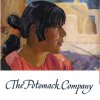









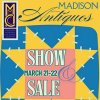





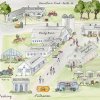


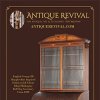





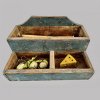
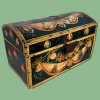
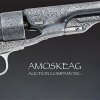









 This portrait of the three-masted schooner Charles Carroll, out of Rockland, Maine, on the Piscataqua River, with the shores of Kittery, Maine, to the left, was painted in 1875. An inscription on the reverse reads, “On the Piscataqua from north end of Noble’s Bridge / Original Thos. P. Moses / Portsmouth, N.H. / The Fall of 1875.” It is the last work completed by Thomas P. Moses (1808-1881) and is considered his masterpiece. In many ways it depicts the sunset of the shipping industry that built fortunes in Portsmouth and would disappear in the next century. It is possible to place the ship near the current New Hampshire State Pier with the wharves of Bow and Ceres Streets beyond.
This portrait of the three-masted schooner Charles Carroll, out of Rockland, Maine, on the Piscataqua River, with the shores of Kittery, Maine, to the left, was painted in 1875. An inscription on the reverse reads, “On the Piscataqua from north end of Noble’s Bridge / Original Thos. P. Moses / Portsmouth, N.H. / The Fall of 1875.” It is the last work completed by Thomas P. Moses (1808-1881) and is considered his masterpiece. In many ways it depicts the sunset of the shipping industry that built fortunes in Portsmouth and would disappear in the next century. It is possible to place the ship near the current New Hampshire State Pier with the wharves of Bow and Ceres Streets beyond.
 This is the third time this pair of portrait miniatures of a lady and a sea captain has been sold in New York City. The watercolor on card paintings, 4¾" x 3¾", sold at Sotheby’s twice; in January 1989, they sold for $1980 when the buyer’s premium was 10%, and they sold in October 1996 for $3737 when the buyer’s premium was 15%. This time they sold for $3500 (est. $2000/4000).
This is the third time this pair of portrait miniatures of a lady and a sea captain has been sold in New York City. The watercolor on card paintings, 4¾" x 3¾", sold at Sotheby’s twice; in January 1989, they sold for $1980 when the buyer’s premium was 10%, and they sold in October 1996 for $3737 when the buyer’s premium was 15%. This time they sold for $3500 (est. $2000/4000). This American school 19th-century pair of portrait miniatures of a lady and a gentleman, gouache on paper, 4¼" x 3¼", each with original giltwood frame (not shown), sold for $2250 (est. $1000/1500). At Sotheby’s on January 18, 1998, they sold for $1035.
This American school 19th-century pair of portrait miniatures of a lady and a gentleman, gouache on paper, 4¼" x 3¼", each with original giltwood frame (not shown), sold for $2250 (est. $1000/1500). At Sotheby’s on January 18, 1998, they sold for $1035. This late 19th-century/early 20th-century large whaling scene, oil on canvas, 39" x 99½", sold in the salesroom for $221,000 (est. $30,000/50,000). It was part of the Credit Suisse consignment.
This late 19th-century/early 20th-century large whaling scene, oil on canvas, 39" x 99½", sold in the salesroom for $221,000 (est. $30,000/50,000). It was part of the Credit Suisse consignment. Deaccessioned by the Terra Foundation, this Chinese school oil on glass was after an early 19th-century John James Barralet (1747-1815) engraving made for what would have been George Washington’s 71st birthday. Inscribed in the plinth was “SACRED / to the Memory of WASHINGTON / OB 14 Dec AD 1799 / AEt 68.” It sold for $32,500 (est. $5000/10,000) to an absentee bidder. A similar example is at Winterthur, and an article was published about it in Winterthur Portfolio, 1977, volume 12.
Deaccessioned by the Terra Foundation, this Chinese school oil on glass was after an early 19th-century John James Barralet (1747-1815) engraving made for what would have been George Washington’s 71st birthday. Inscribed in the plinth was “SACRED / to the Memory of WASHINGTON / OB 14 Dec AD 1799 / AEt 68.” It sold for $32,500 (est. $5000/10,000) to an absentee bidder. A similar example is at Winterthur, and an article was published about it in Winterthur Portfolio, 1977, volume 12. A Federal mahogany figured maple and casuarina veneered worktable attri-buted to the Seymour shop, 1800-10, 30" x 21 3/8" x 17 1/8", sold for $40,000 (est. $30,000/50,000) to Todd Prickett of C.L. Prickett, Yardley, Pennsylvania. It came from the Mitchel Taradash collection via Israel Sack, Inc. to Martin Wunsch. The top drawer lacks its adjustable writing stand, and the basket is reupholstered. It has lunette inlay running along the top edge.
A Federal mahogany figured maple and casuarina veneered worktable attri-buted to the Seymour shop, 1800-10, 30" x 21 3/8" x 17 1/8", sold for $40,000 (est. $30,000/50,000) to Todd Prickett of C.L. Prickett, Yardley, Pennsylvania. It came from the Mitchel Taradash collection via Israel Sack, Inc. to Martin Wunsch. The top drawer lacks its adjustable writing stand, and the basket is reupholstered. It has lunette inlay running along the top edge. This Federal brass-mounted mahogany, satinwood, and casuarina veneered worktable, attributed to Thomas Seymour (1771-1848), possibly with John Seymour (1738-1818), Boston, 1805-12, from the estate of New York collector Martin Wunsch, appears to retain is original brasses. It is 29½" x 21 3/8" x 17 1/8". The top drawer opens to reveal a ratcheted writing stand retaining its original baize. Lunette inlays run along the outer edge, a feature associated with the Seymour shop. The silk bag is in tatters, and the sewing box is replaced. It sold on the phone for $87,500 (est. $50,000/80,000). Its provenance was traced back to Matilda Ray Sumner, who married Elihu Greene of Rhode Island in 1830. The worktable may have been made for her parents, architect Thomas Waldron Sumner and Elizabeth Hubbard of Boston and Brookline, Massachusetts. At the Meyer sale at Sotheby’s in January 1996, a worktable with similar brasses but turned feet sold for $189,500 (est. $30,000/40,000) to dealer Bill Samaha of Massachusetts.
This Federal brass-mounted mahogany, satinwood, and casuarina veneered worktable, attributed to Thomas Seymour (1771-1848), possibly with John Seymour (1738-1818), Boston, 1805-12, from the estate of New York collector Martin Wunsch, appears to retain is original brasses. It is 29½" x 21 3/8" x 17 1/8". The top drawer opens to reveal a ratcheted writing stand retaining its original baize. Lunette inlays run along the outer edge, a feature associated with the Seymour shop. The silk bag is in tatters, and the sewing box is replaced. It sold on the phone for $87,500 (est. $50,000/80,000). Its provenance was traced back to Matilda Ray Sumner, who married Elihu Greene of Rhode Island in 1830. The worktable may have been made for her parents, architect Thomas Waldron Sumner and Elizabeth Hubbard of Boston and Brookline, Massachusetts. At the Meyer sale at Sotheby’s in January 1996, a worktable with similar brasses but turned feet sold for $189,500 (est. $30,000/40,000) to dealer Bill Samaha of Massachusetts. This Classical brass-mounted mahogany marble-top pier table by Charles-Honoré Lannuier (1779-1819), New York, 1805-10, stamped four times on the top of the front legs and back of rear legs “H Lannuier / New York,”the underside of a drawer with a printed label reading “HONORE LANNIUER [sic] / CABINET / MAKER / (FROM PARIS) / Keeps his Ware-house and Manufactory / AND NEWEST FASHION / AT No 60 BROAD-STREET,” marble top replaced, 33½" x 31" x 14", sold for $37,500 (est. $10,000/20,000). It is illustrated in the catalog for the 1998 Lannuier exhibition at the Met by Peter Kenny, Frances F. Bretter, and Ulrich Leben. It is one of the earliest of Lannuier’s tables. Two related tables, one at Winterthur and the other in the collection of John Kean on long-term loan to the Liberty Hall Foundation in Union, New Jersey, have brass galleries. Although it had restoration to the feet and lower platform, its rarity and good design provoked competitive bidding.
This Classical brass-mounted mahogany marble-top pier table by Charles-Honoré Lannuier (1779-1819), New York, 1805-10, stamped four times on the top of the front legs and back of rear legs “H Lannuier / New York,”the underside of a drawer with a printed label reading “HONORE LANNIUER [sic] / CABINET / MAKER / (FROM PARIS) / Keeps his Ware-house and Manufactory / AND NEWEST FASHION / AT No 60 BROAD-STREET,” marble top replaced, 33½" x 31" x 14", sold for $37,500 (est. $10,000/20,000). It is illustrated in the catalog for the 1998 Lannuier exhibition at the Met by Peter Kenny, Frances F. Bretter, and Ulrich Leben. It is one of the earliest of Lannuier’s tables. Two related tables, one at Winterthur and the other in the collection of John Kean on long-term loan to the Liberty Hall Foundation in Union, New Jersey, have brass galleries. Although it had restoration to the feet and lower platform, its rarity and good design provoked competitive bidding. High-quality watercolor portrait miniatures are in demand. These three sold online to the trade for $18,750 (est. $3000/5000). The largest is 5¾" x 5"; the smallest is 3¾" x 3".
High-quality watercolor portrait miniatures are in demand. These three sold online to the trade for $18,750 (est. $3000/5000). The largest is 5¾" x 5"; the smallest is 3¾" x 3". This portrait of Abraham Lincoln by Daniel Huntington (1816-1906) was also one of the Chamber of Commerce portraits acquired by Donaldson, Lufkin & Jenrette. It sold for $65,000 (est. $8000/12,000). Daniel Huntington studied with Samuel F.B. Morse at Yale and later with Henry Inman. In 1833-35, he was at Hamilton College in Clinton, New York, where he met the portrait painter Charles Loring Elliott, who encouraged him to become an artist. He painted some Hudson River school landscapes, traveled in Europe, and returned to America in 1840. After another trip to Rome he returned to New York and devoted his time to portrait painting and genre, religious, and historical subjects. From 1851 to 1859, he was in England. He came back to New York where from 1862 to 1870 and again from 1877 to 1890 he was president of the National Academy of Design. He was also vice president of the Metropolitan Museum of Art. Not shown, Huntington’s portraits of General Ulysses S. Grant and William Tecumseh Sherman, both painted in 1875, also sold as part of the Credit Suisse consignment. Grant brought $43,750 (est. $3000/5000), and Sherman brought $50,000 (est. $3000/5000). A portrait of William H. Vanderbilt by Eastman Johnson (1824-1906), signed and dated 1887, 30" x 25", sold for $40,000 (est. $2000/4000). All went to the same buyer. A portrait of J. Pierpont Morgan by Fedor Encke (1851-1936), painted in 1903, from the same Credit Suisse consignment, sold for $32,500 (est. $2000/4000) to another buyer on the phone.
This portrait of Abraham Lincoln by Daniel Huntington (1816-1906) was also one of the Chamber of Commerce portraits acquired by Donaldson, Lufkin & Jenrette. It sold for $65,000 (est. $8000/12,000). Daniel Huntington studied with Samuel F.B. Morse at Yale and later with Henry Inman. In 1833-35, he was at Hamilton College in Clinton, New York, where he met the portrait painter Charles Loring Elliott, who encouraged him to become an artist. He painted some Hudson River school landscapes, traveled in Europe, and returned to America in 1840. After another trip to Rome he returned to New York and devoted his time to portrait painting and genre, religious, and historical subjects. From 1851 to 1859, he was in England. He came back to New York where from 1862 to 1870 and again from 1877 to 1890 he was president of the National Academy of Design. He was also vice president of the Metropolitan Museum of Art. Not shown, Huntington’s portraits of General Ulysses S. Grant and William Tecumseh Sherman, both painted in 1875, also sold as part of the Credit Suisse consignment. Grant brought $43,750 (est. $3000/5000), and Sherman brought $50,000 (est. $3000/5000). A portrait of William H. Vanderbilt by Eastman Johnson (1824-1906), signed and dated 1887, 30" x 25", sold for $40,000 (est. $2000/4000). All went to the same buyer. A portrait of J. Pierpont Morgan by Fedor Encke (1851-1936), painted in 1903, from the same Credit Suisse consignment, sold for $32,500 (est. $2000/4000) to another buyer on the phone. Horatio Stone’s portrait bust of Alexander Hamilton, 30" high, inscribed and dated “HORATIO STONE FEC ROME 1867,” sold for $37,500 (est. $5000/8000). In 1866 Stone received a commission for a full-length oversize marble statue of Alexander Hamilton, first secretary of the treasury of the United States, for the rotunda of the U.S. Capitol in Washington, where it stands today. This bust may have been part of the preparatory work for the commission. Stone used a terra cotta of Hamilton done from life by Giuseppe Ceracchi in 1791 or 1792 as inspiration. Stone (1808-1875), who spent much of his life in Carrara, Italy, known for its marble quarries, was a medical doctor before turning his attention to sculpture in the 1840s. He moved to Washington, D.C., in 1948, and in 1856 cofounded and became president of the Washington Art Association. It was appropriate art for Donaldson, Lufkin & Jenrette, but apparently Credit Suisse was happy to sell it.
Horatio Stone’s portrait bust of Alexander Hamilton, 30" high, inscribed and dated “HORATIO STONE FEC ROME 1867,” sold for $37,500 (est. $5000/8000). In 1866 Stone received a commission for a full-length oversize marble statue of Alexander Hamilton, first secretary of the treasury of the United States, for the rotunda of the U.S. Capitol in Washington, where it stands today. This bust may have been part of the preparatory work for the commission. Stone used a terra cotta of Hamilton done from life by Giuseppe Ceracchi in 1791 or 1792 as inspiration. Stone (1808-1875), who spent much of his life in Carrara, Italy, known for its marble quarries, was a medical doctor before turning his attention to sculpture in the 1840s. He moved to Washington, D.C., in 1948, and in 1856 cofounded and became president of the Washington Art Association. It was appropriate art for Donaldson, Lufkin & Jenrette, but apparently Credit Suisse was happy to sell it. William Edmondson (1874-1951), Nurse Wootton, initialed on the back, limestone, 20½" high x 11½" wide x 11½" deep, sold for $221,000 (est. $50,000/150,000). It was bought from the artist in 1949 by John Henry and Ruth S. Denton of New Jersey and California, and descended in their family and came to auction from Michigan. It was exhibited at the Cheekwood Museum of Art in Nashville from September 2014 to January 2015. Edmondson worked as a janitor at the Women’s Hospital of the State of Tennessee where Nina E. Wootton was director of nursing. In the early ’30s Edmondson established his stonecutting business, creating tombstones for the community and carving freehand sculptures from locally discarded building limestone. It is one of the four seated nudes by Edmondson, and the only one he signed “WM.” Two are in the Cheekwood Museum in Nashville.
William Edmondson (1874-1951), Nurse Wootton, initialed on the back, limestone, 20½" high x 11½" wide x 11½" deep, sold for $221,000 (est. $50,000/150,000). It was bought from the artist in 1949 by John Henry and Ruth S. Denton of New Jersey and California, and descended in their family and came to auction from Michigan. It was exhibited at the Cheekwood Museum of Art in Nashville from September 2014 to January 2015. Edmondson worked as a janitor at the Women’s Hospital of the State of Tennessee where Nina E. Wootton was director of nursing. In the early ’30s Edmondson established his stonecutting business, creating tombstones for the community and carving freehand sculptures from locally discarded building limestone. It is one of the four seated nudes by Edmondson, and the only one he signed “WM.” Two are in the Cheekwood Museum in Nashville. Adolf Wölfli (1864-1930), untitled (No. 23),circa 1920, graphite and colored pencil on paper, with a text in cursive script on the back (both sides shown), 13 1/8" x 8 7/8", once in the collection of Surrealist poet and artist Andre Breton and exhibited at the Centre Pompidou in 1991, sold for $56,250 (est. $10,000/20,000). Wölfli, who was hospitalized in the Waldau Clinic in 1885, was the subject of a study by his psychiatrist, Dr. Walter Morgenthaler, published in his A Psychiatric Patient as Artist. His works were collected by Breton and the artist Jean Dubuffet as part of their promotion of Art Brut in the 1940s and 1950s, the earliest promotion of Outsider art. A photograph of this colored drawing hanging in Breton’s studio was included in the catalog and posted during the presale exhibition.
Adolf Wölfli (1864-1930), untitled (No. 23),circa 1920, graphite and colored pencil on paper, with a text in cursive script on the back (both sides shown), 13 1/8" x 8 7/8", once in the collection of Surrealist poet and artist Andre Breton and exhibited at the Centre Pompidou in 1991, sold for $56,250 (est. $10,000/20,000). Wölfli, who was hospitalized in the Waldau Clinic in 1885, was the subject of a study by his psychiatrist, Dr. Walter Morgenthaler, published in his A Psychiatric Patient as Artist. His works were collected by Breton and the artist Jean Dubuffet as part of their promotion of Art Brut in the 1940s and 1950s, the earliest promotion of Outsider art. A photograph of this colored drawing hanging in Breton’s studio was included in the catalog and posted during the presale exhibition. Phone bidders competed for this double-sided Henry Darger (1892-1973) watercolor and graphite collage with carbon transfers (from magazines, packaging, and illustrated and coloring books) on pieced paper. The 23½" x 108" artwork (both sides shown) is titled Watch Where You Are Going Kid You’ll Run Smack Into Those Phanto Flowers and sold for $401,000 (est. $400,000/600,000). Not shown, a smaller Darger, At Wickey Sansinia Are Persued [sic] Most Vigorously During Third Thunderstorm but Escape Shooting Down Many Persuers,watercolor, graphite, and ink and carbon transfers on pieced paper, 19" x 47", sold for $185,000 (est. $150,000/250,000).
Phone bidders competed for this double-sided Henry Darger (1892-1973) watercolor and graphite collage with carbon transfers (from magazines, packaging, and illustrated and coloring books) on pieced paper. The 23½" x 108" artwork (both sides shown) is titled Watch Where You Are Going Kid You’ll Run Smack Into Those Phanto Flowers and sold for $401,000 (est. $400,000/600,000). Not shown, a smaller Darger, At Wickey Sansinia Are Persued [sic] Most Vigorously During Third Thunderstorm but Escape Shooting Down Many Persuers,watercolor, graphite, and ink and carbon transfers on pieced paper, 19" x 47", sold for $185,000 (est. $150,000/250,000).


